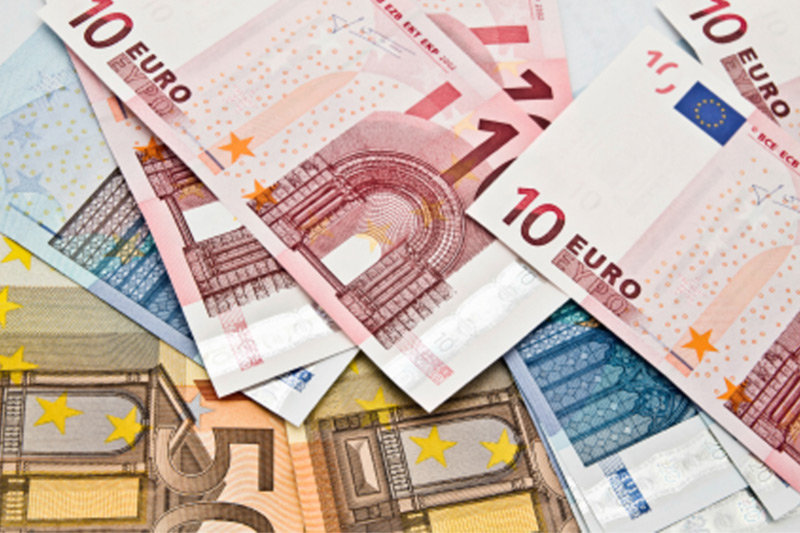Investing.com - The euro was mixed to higher against its major counterparts on Wednesday, after euro zone finance ministers formally approved a second bailout for Greece, but the greenback remained broadly stronger amid diminished expectations for fresh easing by the Federal Reserve.
During European late morning trade, the euro inched higher against the U.S. dollar, with EUR/USD easing up 0.02% to hit 1.3084.
The euro found support after Eurogroup head Jean-Claude Juncker said euro zone finance ministers had formally approved the release of a second financial aid package for Greece, worth EUR130 billion.
Elsewhere, official data showed that industrial production across the euro zone rose in January for the first time in three months, while the annualized rate of consumer price inflation was unchanged in February and remained above the European Central Bank’s target.
The single currency was higher against the yen, with EUR/JPY advancing 0.68% to hit 109.24.
But the euro remained lower against the pound, with EUR/GBP slipping 0.13% to hit 0.8318.
In the U.K. earlier, official data showed that the number of people claiming unemployment benefits rose more-than-expected in February, while the unemployment rate held steady at 8.4%, the highest level since 1995.
The euro advanced to a five-week high against the Swiss franc, with EUR/CHF climbing 0.24% to hit 1.2105, is investors eyed the Swiss National Bank’s policy meeting on Thursday.
Earlier Wednesday, a report showed that Swiss economic sentiment improved this month, rising significantly for the third consecutive month.
The Centre for European Economic Research (ZEW) said its indicator of economic sentiment improved by 21.2 points to a flat reading of 0.0 from a reading of minus 21.2 in February.
The shared currency was broadly higher against the Australian, New Zealand and Canadian dollars, with EUR/AUD adding 0.58% to hit 1.2470, EUR/NZD jumping 1.18% to hit 1.6078 and EUR/CAD rising 0.24% to hit 1.2965.
In Australia, a report earlier showed that consumer confidence slumped in March, as uncertainty over the global economic outlook weighed and as major banks raised mortgage rates, despite two successive rate cuts by the central bank late last year.
Meanwhile, the greenback remained broadly stronger as investor’s trimmed back expectations for a fresh round of monetary easing after the Fed upgraded its outlook for the economy in Tuesday’s rate statement.
The Fed said it now expects to see “moderate economic growth” after its January statement said growth would be “modest” and added that higher oil prices could place upward pressure on inflation.
During European late morning trade, the euro inched higher against the U.S. dollar, with EUR/USD easing up 0.02% to hit 1.3084.
The euro found support after Eurogroup head Jean-Claude Juncker said euro zone finance ministers had formally approved the release of a second financial aid package for Greece, worth EUR130 billion.
Elsewhere, official data showed that industrial production across the euro zone rose in January for the first time in three months, while the annualized rate of consumer price inflation was unchanged in February and remained above the European Central Bank’s target.
The single currency was higher against the yen, with EUR/JPY advancing 0.68% to hit 109.24.
But the euro remained lower against the pound, with EUR/GBP slipping 0.13% to hit 0.8318.
In the U.K. earlier, official data showed that the number of people claiming unemployment benefits rose more-than-expected in February, while the unemployment rate held steady at 8.4%, the highest level since 1995.
The euro advanced to a five-week high against the Swiss franc, with EUR/CHF climbing 0.24% to hit 1.2105, is investors eyed the Swiss National Bank’s policy meeting on Thursday.
Earlier Wednesday, a report showed that Swiss economic sentiment improved this month, rising significantly for the third consecutive month.
The Centre for European Economic Research (ZEW) said its indicator of economic sentiment improved by 21.2 points to a flat reading of 0.0 from a reading of minus 21.2 in February.
The shared currency was broadly higher against the Australian, New Zealand and Canadian dollars, with EUR/AUD adding 0.58% to hit 1.2470, EUR/NZD jumping 1.18% to hit 1.6078 and EUR/CAD rising 0.24% to hit 1.2965.
In Australia, a report earlier showed that consumer confidence slumped in March, as uncertainty over the global economic outlook weighed and as major banks raised mortgage rates, despite two successive rate cuts by the central bank late last year.
Meanwhile, the greenback remained broadly stronger as investor’s trimmed back expectations for a fresh round of monetary easing after the Fed upgraded its outlook for the economy in Tuesday’s rate statement.
The Fed said it now expects to see “moderate economic growth” after its January statement said growth would be “modest” and added that higher oil prices could place upward pressure on inflation.
